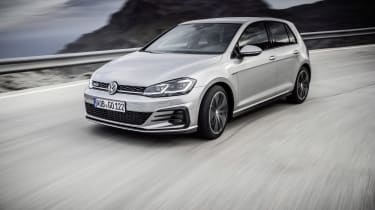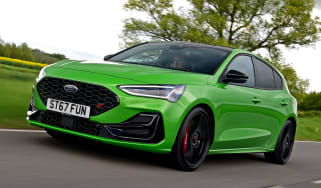Volkswagen Golf GTD hatchback (2013-2019) - Engines, drive & performance
Few people will be disappointed by the Volkswagen Golf GTD’s sheer breadth of talent
Volkswagen wouldn’t have given its most powerful Golf diesel model a GTD badge if it didn’t offer similar driving thrills to the petrol-engined VW Golf GTI. And it doesn’t disappoint – it’s fast, fun and surprisingly comfortable. The diesel engine has been engineered to make as appealing a noise as possible, but still doesn’t sound quite as evocative as the petrol GTI.
VW’s latest seven-speed dual-clutch DSG automatic gearbox is a pleasure to use, with immediate gearshifts and a smoother feel than the transmission in pre-2017 Golfs. If you choose manual mode. the steering-wheel-mounted paddles respond quickly and the car doesn’t override your gearchange decisions like some others do. However, those who value driving fun above all else should pick the brilliant manual. Thanks to the GTD's huge reserves of power, it requires very few gearchanges, even when you’re driving quickly.
The Volkswagen Golf GTD comes with a driver profile system, which allows you to alter the weight of the steering and how the accelerator responds, in order to maximise the car’s fuel economy or make it feel sportier. If you specify the optional adaptive dampers for around £800, you can also adjust the suspension settings, making the car more comfortable on the motorway and even more fun to drive on a twisty country road.
Volkswagen Golf GTD diesel engine
The GTD’s 182bhp 2.0-litre turbocharged diesel engine accelerates the car from 0-62mph in 7.4 seconds (with a DSG gearbox) and tops out at 143mph. While on paper this is a full second and nine miles per hour slower than the petrol GTI, it feels nearly as fast on the road.
It’s a very impressive engine, which offers plenty of overtaking ability thanks to the way it delivers its power. It also feels relaxed around town – especially if you choose the DSG automatic gearbox. The way the engine outputs its power is surprisingly smooth. Normally most of the power in a diesel engine is in the middle of the rev range, but you can go from idle to the redline and feel the same direct acceleration in the GTD.
Clever electronics in the front axle mean that power is always sent to the wheels with the most grip, which means the car can make the most of its responsive steering. Ultimately, we don’t think the Golf GTD is quite as rewarding to drive as a diesel Ford Focus ST, but it comes very close and makes more financial sense.














